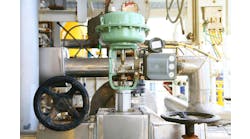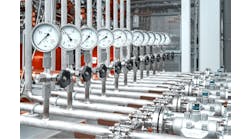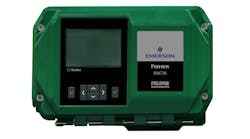PHOENIX -- Honeywell Process Solutions used its annual user group meeting this week in Phoenix to show off new products, including a line of wirelss valve positioners, a portfolio of solutions to help manufacturers run "green" operations, and a bulk-liquid terminal management application.
The latest addition to Honeywell’s OneWireless industrial wireless portfolio is based on one of the company’s most-proven sensor technologies, the Micro Switch CX series hazardous location analog sensor. The new XYR 6000 Valve Position Sensor monitors the position of the valve when used in OneWireless systems, sending the signal from remote or potentially dangerous areas of the plant. The sensor carries all the appropriate hazardous location certifications, which, says Honeywell, makes it ideal for applications such as monitoring valve positioner status, manual process valve position, safety shower and eye bath notification, tank overflow alarms, damper and louver position, door/gate position or other applications where installing wires is inefficient, cost-prohibitive or simply unsafe.
In addition to eliminating manual monitoring, the sensor’s accuracy improves safety by identifying linear or rotary valve positions, minimizing the risk of unwanted fluid release or unplanned product contamination. When used for safety shower notification, the sensor can serve as an emergency response trigger. The XYR 6000 Valve Position Sensor also simplifies maintenance by electronically tagging each valve in the system, identifying valves that have degraded or been damaged. This reduces the need for field technicians to manually inspect valves for maintenance.
Honeywell also unveiled Energy Management Solutions, a customizable portfolio of new and existing hardware, software and services to help improve energy efficiency and reduce greenhouse gas (GHG) emissions. The portfolio is targeted to a wide range of energy-intensive process manufacturing facilities. In the area of refining and petrochemical production, it leverages expertise from Honeywell’s UOP subsidiary, which is a leading developer and licensor of process technology for refining and petrochemical industry.
The portfolio features the new Honeywell Energy Dashboard, which gathers information from various instruments and systems and tracks their energy consumption against dynamic energy targets. Capturing and analyzing this data allows users to understand key energy indicators and how they affect overall energy consumption. The Energy Dashboard, expected to be commercially available in the fourth quarter 2009, enables users to establish specific goals for reducing energy consumption, costs and the associated GHG emissions, as well as to measure actual performance against those goals.
Once energy saving potential has been identified, the Energy Management Solutions portfolio provides customizable hardware, software and services to improve performance, including enhancements to measurement and monitoring, control and optimization, heat recovery, feedstock optimization, advanced process technology, utilities optimization and services to sustain and even improve results over time.
The company claims that for refining and petrochemical industries, HPS and UOP solutions can reduce energy consumption by up to 25 percent and the associated GHG emissions by up to 320 metric kilotons per year. For other process manufacturing industries like pulp and paper, Energy Management Solutions can help reduce energy consumption by up to 20 percent and associated GHG emissions by up to 44 metric kilotons per year.
In a third announcement, Honeywell described its Terminal Manager, a new distribution-automation system designed to help process manufacturers more safely and efficiently load and unload trucks, rail cars and ships in bulk-liquid terminals. Terminal Manager optimizes the distribution process by linking terminal operations into Honeywell’s Experion Process Knowledge System (PKS), one of the process industry’s most widely used platforms for control system automation.
Through Experion, Terminal Manager integrates with subsystems such as safety and security solutions, advanced control applications, such as blending and movement, and most standard equipment found at terminals, including weigh scales, flow computers, tank gauges and automated valves. This integrated approach allows manufacturers to limit risks involved with filling large tanks with volatile products and to keep constant tabs on all products that come into and leave their terminals.
Terminal Manager provides a secure database for a variety of information, including the custody-transfer transaction data from instrumentation, which provides legal-transfer points for billing and tax purposes; vehicle/driver data on each vehicle that enters the terminal to match orders to the right vehicles; and inventory management data that interfaces to pipeline and tank monitoring systems, providing detailed balance reports.
The database houses order and shipment data from enterprise resource planning (ERP) systems to support the invoicing and payment of products before vehicles leave the terminal. The system also provides a secure audit trail that captures the minute-by-minute history of each event and activity in the terminal. This allows the refinery to detect even the smallest product losses caused by incidents such as theft.
Terminal Manager integrates with safety solutions such as fire and gas detection devices, overfill sensors, ground detection devices and safety controllers such as Honeywell’s Safety Manager. This integration enables the system to identify abnormal conditions before they escalate into safety incidents.
“Some manufacturers may mistakenly believe that process automation is only applicable to activity within a plant or refinery,” said Hillman. “Terminal Manager, however, was designed to help those manufacturers extend process automation to their distribution networks. This strategy enables solutions such as Experion to further protect the bottom line.”


